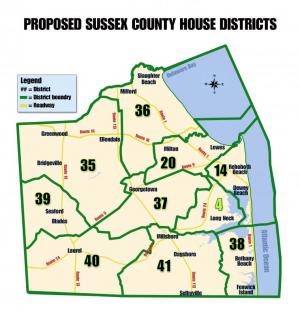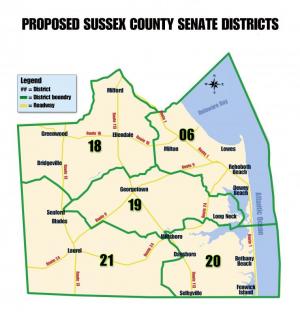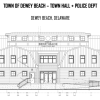Communities from Slaughter Beach to Long Neck lodged their concerns about proposed legislative maps that change their representative districts.
Sandy Spence, who lives in Senate District 6, said she is concerned about the LGBTQ community under the proposed maps presented during public hearings held Oct. 18 and 19.
“The proposed lines dilute the voting power of the LGBTQ community, in addition to others who respect diversity,” she said.
Mitch Crane said he requests the proposed 6th Senate District be amended because of its impact on the LGBTQ community. “The proposed lines remove a significant percentage of the LGBTQ residents from the current 6th District where most of such residents of southern Delaware live, and place them in the 19th District which has a small such population. By doing so, it dilutes the impact of the gay community which shares political beliefs,” he said.
Paulette Rappa, a Long Neck resident who has run for the House 37th District seat and also county council, said Sussex County’s existing districts do not preserve or protect the values of its emerging residents.
She said District 37 represents two different worlds.
“One end, transplants and liberal social issues and the other end, conservative influence and local lineage. It is that end that dominates the district’s culture, morals and customs,” she said. “The proposed Senate map of District 6 abandons the gay community that has settled outside of incorporated Lewes and Rehoboth.”
Leslie Ledogar, 14th District Democratic Committee chair, asked that the western district line of Senate District 6 be moved west to at least Hopkins Road and the southern line be moved to Hollymount Road.
“This would ensure that communities such as The Ridings of Rehoboth and all of the new developments in the area between Route 1 and Route 5 are fairly represented,” she said.
She said these are communities of interest with shared common values. “Many liberal and progressive constituents do not share the belief systems of their neighbors west of Route 5,” she said.
Ledogar also asked that Love Creek be used as a district boundary line so The Retreat at Love Creek is not moved out of its current district.
Speaker of the House Rep. Pete Schwartzkopf, D-Rehoboth Beach, who is leading the redistricting process with Senate President Pro Tempore Dave Sokola, D-Newark, said increased downstate population resulted in moving the 4th District from New Castle County to Sussex County. He said the new 4th District boundaries were created because many residents have very similar issues – in the upper age range of the population, living in manufactured housing, and affected by flooding issues.
Slaughter Beach officials protest change
Representing about 300 residents of Slaughter Beach, Mayor Kathleen Locke objected to new lines that take her town out of the 18th District and put it into the 16th District.
“We are working with the Association of Coastal Towns to secure long-term funding for coastal nourishment and infrastructure projects,” she said. “I believe that the town’s long-term relationships with our current reps will help accomplish our goals.”
Larry Meinert, a Slaughter Beach town council member, said the town has been working with Sussex County on joining a sewer district, and moving it to another voting district would harm that project. He asked that the town be kept in a Sussex County district to protect its interests. “Moving the line to the north of Slaughter Beach so we remain within Sussex County is not going to have any significant impact upon the overall redistricting,” he said.
Dwayne Bensing of the American Civil Liberties Union of Delaware said the voting strength of a community of interest should be preserved over keeping an incumbent in a district.
He said there are at least 14 proposed districts with border incumbents that split at least 12 communities of interest. A community of interest refers to a group of people with a common set of concerns that may be affected by legislation along ethnic, racial or economic matters.
Bensing described some of the more unusual boundary lines drawn on the proposed map, and asked that single, compact districts be considered instead.
“District 17 looks like Washington crossing the Delaware. District 2 looks like a megaphone, District 5 looks like a Wu-Tang Clan logo,” he said.
Schwartzkopf said some districts have odd shapes because of census blocks. Breaking up a census block can affect communities of interest, he said, and they did not break any up in the redistricting map. He said they worked to keep minority and majority populations as close as possible to the previous redistricting map.
“Adding one census block to add population or keep communities of interest together can result in districts taking on very odd shapes,” Schwartzkopf said. “There is an ability to break up a census block, but we do not do that because it is a sure-fire way of ending up in federal district court.”
This year’s redistricting map also changed regarding prison populations. Inmates housed in prison are no longer counted as part of the district population. Instead, they are counted as residents of their last known address. A total of 3,761 inmates will be counted as residents of their last known address; 637 remain in the prison district because their last known address could not be confirmed.
House Minority Leader Rep. Dan Short, R-Seaford, said Republicans generally support the proposed lines, but he criticized drawing Rep. Mike Ramone, R-Newark, out of his district and into the district held by Rep. Paul Baumbach, R-Newark.
Short said Republicans have drawn a map that makes some minor tweaks so that both representatives remain in their districts.
“We ask that you avoid the unfair situation of combining two representatives together, one who has a significant advantage over the other,” he said.
Schwarztkopf said it is not good practice to put two representatives in the same district, but it is not illegal. He said Ramone lives on the line of the previous map, and they are willing to review the Republican maps.
Revised and final House and Senate maps are expected by late October, and a special session will be held Monday, Nov. 1, for the General Assembly to vote on the final maps. These maps will demarcate the legislative districts for the next decade until population numbers are recounted during the 2030 census.
Delaware’s districts are drawn with a 5 percent population deviation both above and below the state’s average. Wilmington districts are largely below the state average while Sussex County districts are largely above it.
Lewes resident Eul Lee said the district populations in rapidly growing Sussex County areas should be below the state average.
“The rapid growth area should be drawn with minus 5 percent so that in the next 10 years the district’s population does not grow much bigger than other slow growth areas,” she said.























































